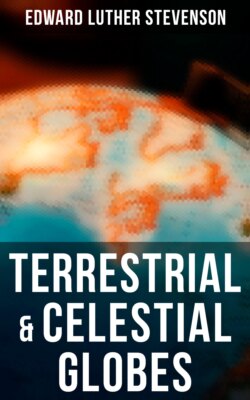Читать книгу Terrestrial & Celestial Globes - Edward Luther Stevenson - Страница 9
На сайте Литреса книга снята с продажи.
NOTES
Оглавление30 Cicero’s allusion to Thales, cited p. 16, is probably a reference to a tradition.
31 Wolf, R. Geschichte der Astronomie. München, 1877, p. 193; Gassendi, P. Opera Omnia. Leipzig, 1658. Vol. V, p. 375. See statement by Cicero, cited below, p. 17.
32 Aratus’ poem bore the title, “Phaenomena.” See, for an excellent edition of this poem, Prince, C. L. Phenomena. A literal translation of the astronomy and meteorology of Aratus. Lewes, 1895. In his “Bibliographical remarks,” the translator refers to one hundred and nineteen editions of this poem, dating from the first printed at Bonn in the year 1474. See also n. 48, below.
33 Passeri, G. B. Atlas Farnesianus Marmoreus insigne vetustatis monumentum. (In: Gori, A. F. Thesaurus gemmarum antiquarum astriferarum. Firenze, 1750. Vol. III.); Denza, P. F. Globi celesti della Specola Vaticana. (In: Publicazioni della Specola Vaticana. Torino, 1894. pp. xx-xxiii.)
34 Cicero. De Republica. Bk. I, chap. xiv. The citation is from the translation by Hardingham, G. G. The Republic. London, 1884.
35 Lactantius. Institutiones divinae. Bk. II, chap. v.
36 Pappus. Collectionum mathematicarum. Edited by Commandino. Urbino, 1588. Bk. VII. See especially the introduction.
37 Hultsch, F. Uber den Himmelsglobus des Archimedes. (In: Zeitschrift für Mathematik und Physik. Leipzig, 1878. Bd. 22. Hist. Litt. Abteilung, p. 106.); Same author. “Archimedes.” (In: Real-encyklopädie der klassischen Alterthumswissenschaft.)
38 Wolf, op. cit., pp. 122–124.
39 Wolf, op. cit., pp. 160–166.
40 Wolf, op. cit., p. 130.
41 Ptolemy, C. Syntaxis. (Almagest.) Various editions. Bk. VII, chap. 1. This work was first printed in Venice, 1496; the first Greek text in Basel, 1538. See Hues, Tractatus de Globis, for an analysis of this work.
42 Pliny. Historia Naturalis.
43 Ptolemy, op. cit., Bk. V, chap. i; Bk. VII, chap. v; Bk. VIII, chap. iii. Ptolemy mentions by name forty-eight constellations, all of which he probably obtained from the earlier Greeks. These constellations, the names being still retained, are: The Zodiac.
| Aries | Cancer | Libra | Capricornus |
| Taurus | Leo | Scorpio | Aquarius |
| Gemini | Virgo | Sagittarius | Pisces |
The Northern Hemisphere.
| Andromeda | Corona | Lyra | Ursa Major |
| Aquila | Cygnus | Ophiuchus | Ursa Minor |
| Auriga | Delphinus | Pegasus | Sagitta |
| Boötes | Draco | Perseus | |
| Cassiopeia | Equuleus | Serpens | |
| Cepheus | Hercules | Triangulum |
The Southern Constellations.
| Ara | Cetus | Crater | Lupus |
| Argo Navis | Centaurus | Eridanus | Orion |
| Canis Major | Corona Australis | Hydra | Piscis Australis |
| Canis Minor | Corvus | Lepus |
44 Visconte, P. E. Nota intorno ad un’ antico globo celeste scolpito in marmo porino. Roma, 1835; Gaedechens, R. Der marmorne Himmelsglobus des fürstlich Waldechschen Antikenkabinettes zu Arolsen. Göttingen, 1862.
45 Schanz, M. Geschichte der römischen Litteratur bis zum Gesetzgebungswerk des Kaisers Justinian. München, 1890. See p. 75 for a reference to the astrologer Nigidius Figulus.
46 Coins on which there appears a representation of a globe were numerous. Attention may also here be called to the imperial insignia, a part of which was a globe, which the emperor was represented, in the pictures of the day, as holding in his hand. See King, C. W. Antique Gems and Rings. Vol. II, plates xxvi and xxxviii.
47 Weidler, J. F. Historia astronomiae. Vitembergae, 1741. This author is of the opinion that Leontius lived in the eighth century, p. 201; Susemihl. Geschichte der Griechischen Litteratur der alexandriner Zeit. Leipzig, 1891. See Vol. I, p. 294, for a statement of the belief that Leontius lived in the seventh century.
48 Halma, N. Les Phenoménes d’Aratus de Soles, et de Germanicus Cesar; avec les Scholies de Théon, les catasterismes d’Eratosthenes et la sphère de Leontius traduit … par l’Abbé N. Halma. Gr. avec Fr. Paris, 1821. pp. 65–73.
